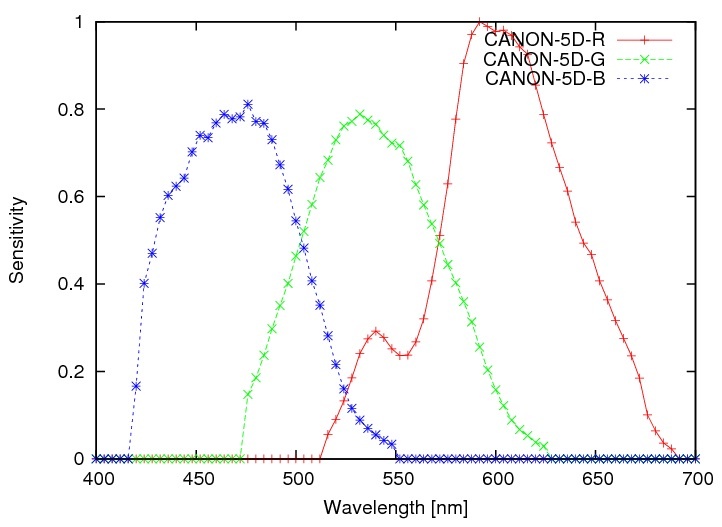...
Instrument and Experimental Design
We used a Canon 5D Mark III digital SLR camera with a (initially) 15mm focal length f/2.8 Sigma fisheye lens, pointed at the zenith. The camera is installed beneath a hemispherical plexiglass dome that is installed in the roof of the ALO building on the Cerro Pachon ridge.
The CMOS imager in the Canon 5D camera has a Bayer array in the focal plane, with sub-pixels allocated to BGGR. The relative spectral response of the sensor is shown below.
These bands are fairly close to the astronomical standard BVR set of filters. Although one can obtain modified Canon cameras with the NIR-blocking filter removed, the unit we installed in Jan 2014 was an off-the-shelf version. This will be where Chris Stubbs uploads the information regarding the newly installed Cerro Pachon all sky camera.means the sky brightness in these bands will be dominated by scattered and reflected sunlight and unresolved sources, but we aren't sensitive to OH emission.
We have two measurement objectives:
- To measure the optical transparency of the atmosphere, through clouds and aerosols.
- To measure the surface profile of the sky brightness.
For the first of these our plan is to use the sum of the color channels to obtain the highest possible SNR, and monitor the flux from stars over time. For the sky brightness we'll use the color information of the diffuse background flux.
Data collection is performed using an Apple Mac Mini, and the gphoto2 open source software that can control the Canon 5D camera over a USB cable. A cron job starts execution at a time that depends on the month of the year, and a pair of long (10 sec) and short (1 sec) exposures are obtained each minute. Images are stored as .CR2 format raw image files, and then converted into FITS images using a Tonry-modified version of the dcraw open source code from Dave Coffin. The modified version constructs more complete headers, including MJD, etc.
Here is an example FITS header from one of the single-band images extracted from the CR2 file:
imhead ut121513.0501.short.R.fits
SIMPLE = T
BITPIX = 16
NAXIS = 2
NAXIS1 = 2888 // Image size in x
NAXIS2 = 1924 // Image size in y
NAXIS3 = 1
CNPIX1 = 0 // Image offset in x
CNPIX2 = 0 // Image offset in y
BSCALE = 1.000
BZERO = 0.000
FILENAME= 'ut121513.0501.short.cr2' // Original file name
TIMESTMP= 'Mon Dec 16 05:03:06 2013' // Camera timestamp
DATE-OBS= '2013-12-16T05:03:06' // Exposure date
MJD-OBS = 56642.210486 // Exposure modified Julian date
ZONEHOUR= 0 // [hr] Date minus UTC
INSTRUME= 'Canon EOS 5D Mark III' // Camera name
ISO = 1600.0 // ISO speed
EXPTIME = 1.000000 // [sec] Exposure time
APERTURE= 2.8 // Aperture f-number
FLEN = 15 // [mm] Lens focal length
THUMB1 = 5760 // Actual image size (x)
THUMB2 = 3840 // Actual image size (y)
DAYMULT = '2.391381 0.929156 1.289254' // Daylight multiplier factors
CAMMULT = '1945.0 1024.0 1664.0 1024.0' // Camera multiplier factors
IMSPIX1 = 72 // Image start in x
IMNPIX1 = 2888 // Image npix in x
IMSPIX2 = 0 // Image start in y
IMNPIX2 = 1924 // Image npix in y
BSPIX1 = 0 // Bias start in x
BNPIX1 = 20 // Bias npix in x
BSPIX2 = 10 // Bias start in y
BNPIX2 = 1904 // Bias npix in y
BIAS = 2047.783 // Bias level
NOISE = 11.867 // Noise level
END
Directories, Environment variables, and scripts.
The shell scripts reside in the home directory of user 'christopherstubbs' on the data collection machine. Relevant scripts are
startnight.sh: main collection script, run automatically at desired time
initialize.sh: sets up initial configuration stuff, directory names, etc
makefits.sh: creates fits files from .CR2 files
photometry.sh: runs photometry on the fits files
getsky.sh: does simple statistics in a 400 x 400 pixel box in the center of the image, in each band
wipenight.sh: cleans out directory from a night
makeskyplot.sh: makes .eps file using supermongo of sky brightness vs. MJD for a given night
All data from a given night are collected before any analysis is started. Once the night's collection is finished, the following things happen
- create subdirectories for raw and multi band FITS images
- generate FITS files in 3 bands, put them in the respective directories
- determine the bias level for each image, from the header.
- pull out sky brightness from center of each image, divide by exposure time after subtracting bias level
- do photometry on all sources in each FITS file.
- compress the .cr2 files and move them to the /Volumes/2TB storage disk
- wipe out the intermediate FITS files, but keep the photometry files
- produce a summary file for each night with sky brightness and number of stars detected.
- create a plot of sky brightness vs. time
- transfer data files to Amazon cloud machine
Initial Results
Sky brightness in B,V,R vs. time, for night where moon set at the end of the night
...
